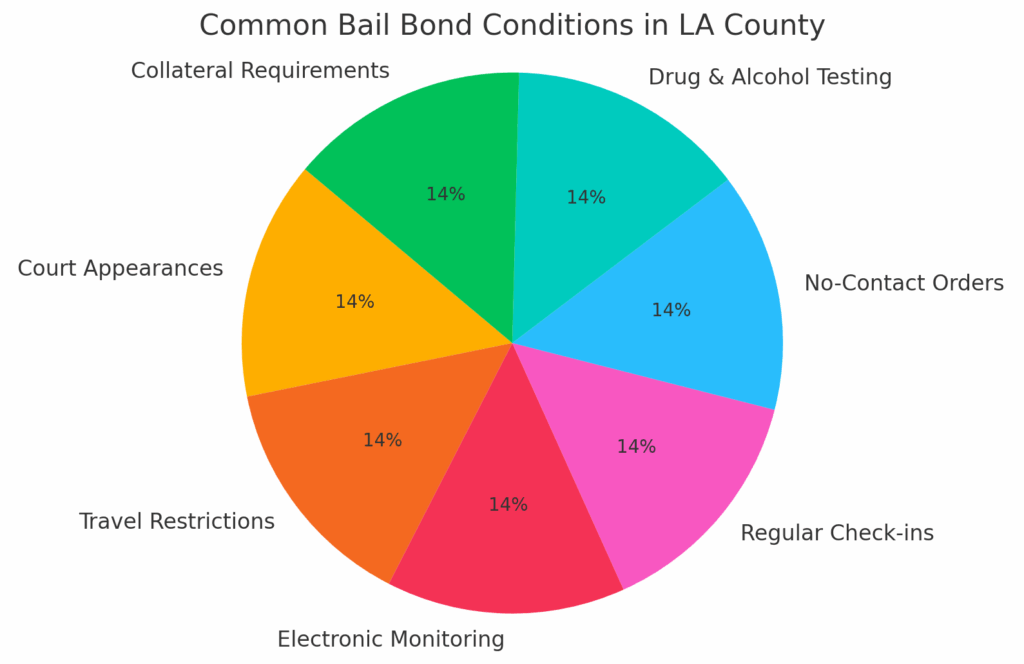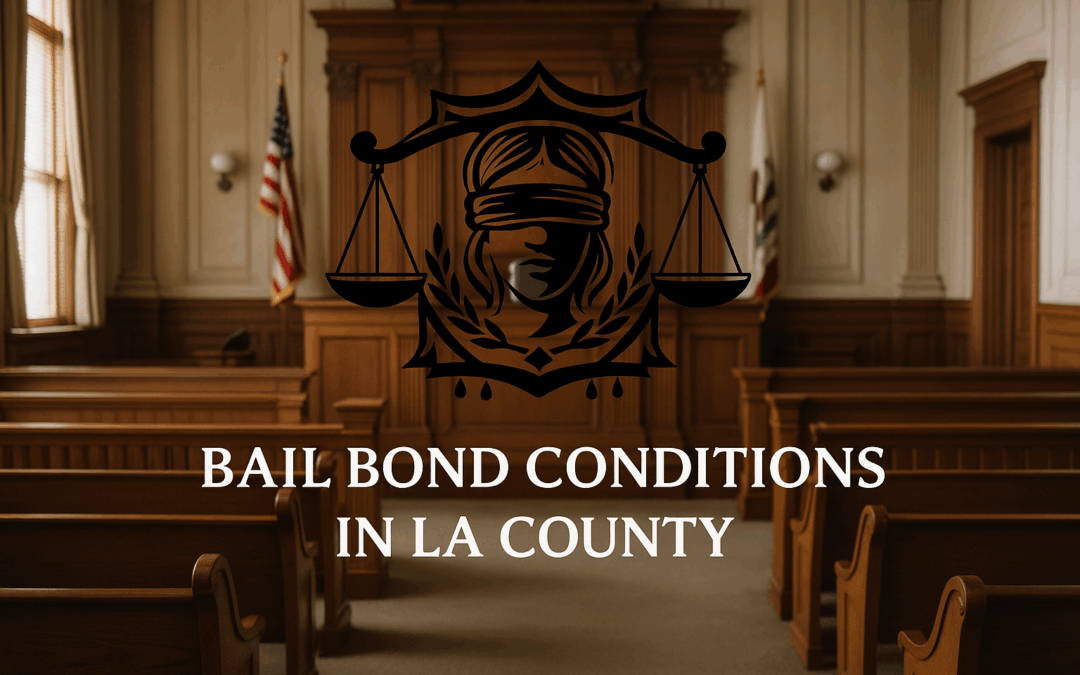When your loved one walks out of a Los Angeles County jail on a bail bond, it’s not freedom without strings attached. Bail bond conditions are legally binding requirements that ensure defendants appear for all court dates and comply with court orders. Failing to meet these conditions can lead to bond forfeiture—and your family could lose collateral or face additional penalties. This comprehensive guide will explain the ins and outs of bail bond conditions in LA County, show you how to prepare, and offer practical tips to keep your case on track.
What Are Bail Bond Conditions?
Bail bond conditions are stipulations set by the court and enforced by your bail bond agent to guarantee a defendant’s appearance in court. They serve two main purposes:
- Ensure Court Appearance
The court needs assurance that the defendant will show up for hearings, arraignments, motions, and trials. - Protect Public Safety
Conditions can include travel restrictions or electronic monitoring for higher-risk cases.
When you secure a bail bond—whether a standard 10% bond or a discounted 1% bail bond plan—you enter into a contract (the indemnity agreement) that holds you and the defendant accountable to these conditions. For more on low-down-payment options, see our deep dive on How 1% Bail Bonds Work in Los Angeles & Why They Save Money.
The Legal Framework Behind Bail Bond Conditions
Bail bond conditions in California derive from both state law and local court rules:
- California Insurance Code
Bail bond agents and surety companies are regulated by the Department of Insurance. You can review agent licensing requirements at the California Department of Insurance: insurance.ca.gov. - California Penal Code & Rules of Court
Specific procedural rules around bail amounts, conditions, and forfeiture are codified in the Penal Code and California Rules of Court. You can explore these statutes here: California Codes & Statutes. - LA County Local Rules
The Superior Court of Los Angeles sets additional practice directions, such as how to submit bail bond paperwork and how to handle forfeiture hearings.
Together, these regulations define the scope, enforcement, and penalties for bail bond conditions in Los Angeles. Understanding this legal backdrop helps you navigate requirements and avoid costly mistakes.
Common Bail Bond Conditions in LA County
While each case is unique, certain conditions appear routinely in LA County bail bonds. Below are the most common stipulations:
1. Mandatory Court Appearances
What It Means:
The defendant must attend every scheduled court hearing—arraignment, plea hearing, preliminary hearing, pre-trial conferences, trial, and sentencing.
How to Prepare:
- Calendar Management: Use a digital calendar (Google Calendar, iCal) to set multiple reminders.
- Court Contact Info: Note the courthouse address and clerk’s office phone number for updates.
Missing even one hearing can result in bond forfeiture. For official LA County court dates and procedures, check the Sheriff’s bail info: LASD Bail Information.
2. Travel Restrictions
What It Means:
Defendants are often restricted to certain geographic boundaries—typically within California, Los Angeles County, or the continental U.S.
How to Prepare:
- Verify Boundaries: Clarify in writing which counties or states the defendant may not leave.
- Obtain Permissions: If travel is necessary (work, family emergency), request advance written permission from the court and your bail agent.
Ignoring travel clauses can lead to active warrants and immediate remand.
3. Electronic Monitoring & Curfews
What It Means:
Some defendants must wear an electronic ankle monitor or observe curfews (e.g., at home between 9 PM and 6 AM).
How to Prepare:
- Device Maintenance: Keep the monitor charged and free of damage.
- Understand Alerts: Learn what triggers an alert—tampering, low battery—and whom to notify.
Consistent compliance shows goodwill to the court and minimizes technical violations.
4. Check-in Requirements
What It Means:
Defendants may need to report in person or by phone/text at regular intervals to confirm they remain in compliance.
How to Prepare:
- Set Alarms: Schedule smartphone alarms for check-in times.
- Reliable Contact Information: Keep the bail agent’s and court’s phone numbers saved and accessible.
Late or missed check-ins can escalate to bond revocation if left unaddressed.
5. No-Contact Orders
What It Means:
In cases involving domestic violence, assault, or stalking, courts often impose no-contact orders with specified individuals.
How to Prepare:
- Clear Boundaries: List the protected person’s name and ensure all household members understand.
- Safe Communication Methods: If contact is required (e.g., via attorney), follow court-approved channels.
Violations of no-contact orders carry serious criminal penalties.
6. Drug & Alcohol Testing
What It Means:
Defendants in DUI or substance-related cases might be subject to random or scheduled testing.
How to Prepare:
- Locate Testing Sites: Note nearby public testing facilities or probation department offices.
- Keep Records: Maintain logs of test dates, times, and results.
Proactive participation demonstrates responsibility to judges and probation officers.
7. Collateral & Co-Indemnitor Responsibilities
What It Means:
Collateral (property, vehicles, jewelry) may be held until case resolution. Co-indemnitors (cosigners) share liability for the bond.
How to Prepare:
- Secure Documentation: Keep titles and deed records organized.
- Discuss Roles: Ensure co-indemnitors know their obligations—missing hearings could cost their assets.
Clear communication among all involved parties prevents misunderstandings and financial disputes.

How to Prepare Yourself and Your Loved One
Meeting bail bond conditions requires organization and clear communication. Here’s a checklist:
- Centralize Documents
- Copies of the bail bond agreement
- Court-issued release orders or no-contact directives
- Electronic monitor user manual (if applicable)
- Digital Toolbox
- Shared calendar invites for court dates
- Contact list: bail agent, attorney, court clerk, jail
- Note-taking app for keeping track of condition updates
- Financial Planning
- Set aside funds for bond fees, monitoring costs, and any required deposits
- Understand refund timelines for cash collateral (if used)
- Communication Protocol
- Decide how updates will flow: group chat, email distribution, or family meetings
- Assign one point person for bail agent liaison and another for court-related queries
Putting these systems in place early minimizes last-minute stress and helps you focus on legal strategy rather than administrative hurdles.
The Role of Your Bail Bond Agent
A skilled bail bond agent does more than post bail; they act as your navigator through bond conditions:
- Paperwork Expert
Agents know which forms the court and probation office require, ensuring error-free submissions. - Condition Clarifier
They explain each condition in plain language, helping you understand travel limits, curfews, and monitoring protocols. - Communication Hub
Agents coordinate directly with the jail, court clerks, and monitoring companies to keep everything on schedule. - Violation Mitigator
If a minor technical violation occurs (missed check-in, low battery on a monitor), they can often negotiate a grace period or avoid bond revocation.
When comparing agents, confirm they’re licensed by the California Department of Insurance (DOI) and have strong LA County local experience. You can verify licenses at insurance.ca.gov.
Consequences of Violating Bail Bond Conditions
Ignoring bail bond conditions isn’t just a paperwork error—it can trigger serious legal and financial fallout:
- Bond Revocation & Arrest Warrant
The court issues a warrant, and the defendant can be rearrested immediately. - Collateral Forfeiture
Collateral used to secure the bond may be seized or sold. - Loss of Premium
The non-refundable bond fee (e.g., 10%) is permanently forfeited. - Increased Bail Amount
Judges may set a higher bail on bond reinstatement. - Criminal Penalties
For serious breaches (violating no-contact orders, absconding), new charges could be filed.
Sticking to conditions is the surest way to avoid these costly and stressful outcomes.
Tips for Smooth Compliance
Follow these best practices to stay on the right side of bail conditions:
- Double-Check Dates: Confirm every court date with your attorney and bail agent.
- Confirm Boundaries: Ask your agent for a written map of travel restrictions if you’re unsure.
- Maintain Open Dialogue: Immediately inform your agent of any changes—new court orders, address changes, or device errors.
- Stay Organized: Keep all bond-related documents in a dedicated folder (physical or digital).
- Set Redundant Reminders: Use phone alerts, sticky notes, and email notifications for critical deadlines.
- Engage Counsel Early: In complex cases, work with an attorney who understands bail bond conditions and can advocate for modifications if needed.
By treating bail bond conditions with the same seriousness as court orders, you safeguard both freedom and finances.
Conclusion
Navigating bail bond conditions in LA County can feel overwhelming, but with the right preparation, support, and attention to detail, you can keep your loved one out of jail and on track for a successful legal outcome. Remember to:
- Review conditions carefully and ask questions
- Use tools like shared calendars and note apps
- Lean on your licensed bail bond agent for guidance
- Stay proactive to avoid violations and forfeitures
If you need expert assistance, contact Deity Bail Bonds any time, day or night. Our experienced team will walk you through every requirement, handle the paperwork, and help you protect both freedom and financial security.
Additional Resources
- California Department of Insurance: Insurance Agent Licensing
- LA County Sheriff’s Bail Information: LASD Bail Info
- California Legal Codes: Penal Code & Rules
This guide is for informational purposes and does not constitute legal advice. Always consult qualified legal counsel for case-specific guidance.

